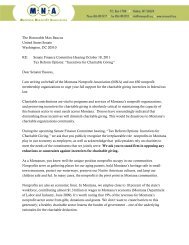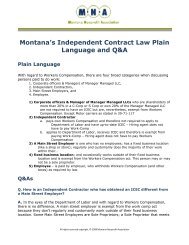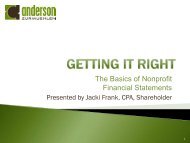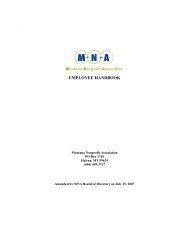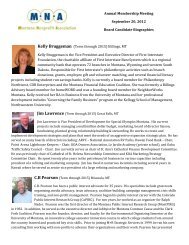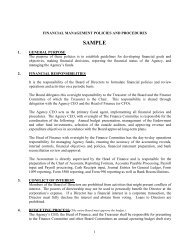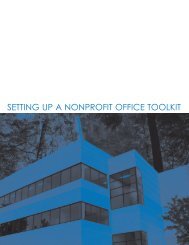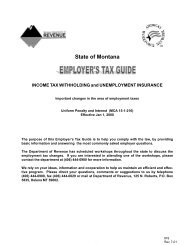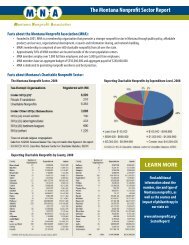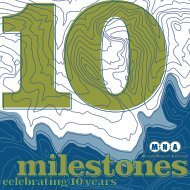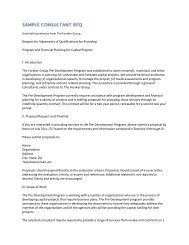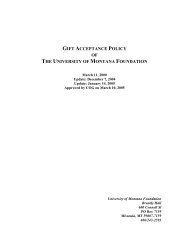Nonprofit Operations Toolkit - Heather Carpenter
Nonprofit Operations Toolkit - Heather Carpenter
Nonprofit Operations Toolkit - Heather Carpenter
Create successful ePaper yourself
Turn your PDF publications into a flip-book with our unique Google optimized e-Paper software.
NONPROFIT OPERATIONS TOOLKIT
<strong>Nonprofit</strong> <strong>Operations</strong> <strong>Toolkit</strong><br />
Welcome to the <strong>Nonprofit</strong> <strong>Operations</strong> <strong>Toolkit</strong>! I created this practical toolkit to help<br />
established nonprofits run more effectively and save money by implementing<br />
important operational procedures.<br />
So in developing this kit, I compiled resources and tips that I use and follow in<br />
managing the day-to-day operations of my own nonprofit.<br />
The toolkit is broken into eight key operational areas critical to running the day-today<br />
operations of any nonprofit organization.<br />
These key operational areas are:<br />
1. Legal<br />
2. Human Resources<br />
3. Accounting/Financial Management<br />
4. Fundraising/Development<br />
5. Board of Directors/Governance<br />
6. Technology<br />
7. Planning<br />
8. Training<br />
Also included is a Bonus Section titled: How to Improve Your <strong>Nonprofit</strong><br />
<strong>Operations</strong> in Under Two Months & 10 <strong>Nonprofit</strong> <strong>Operations</strong> Success Steps.<br />
Following these steps will give you the ability to spend less time on operations and<br />
spend more time focusing your organization’s programmatic activities to successfully<br />
achieve your mission.<br />
Sincerely,<br />
<strong>Heather</strong> <strong>Carpenter</strong><br />
M.M. <strong>Nonprofit</strong> Administration<br />
heathercarpenter@nonprofitalternatives.org<br />
http://www.nonprofitalternatives.org<br />
http://nonprofitleadership601.blogspot.com<br />
1
<strong>Nonprofit</strong> <strong>Operations</strong> <strong>Toolkit</strong><br />
1. Legal<br />
<strong>Nonprofit</strong>s can benefit greatly from legal advice and council and potentially prevent<br />
expensive law suits or having to pay unnecessary fees. Working with attorneys on a<br />
regular basis could potentially save an organization money in the long run.<br />
Getting Legal Help and Training<br />
Bar Associations are a great place for nonprofits to receive free legal advice and<br />
training. There are pro-bono resources and free classes available for nonprofits<br />
through many local Bar Associations. In addition, some Law Firms provide free legal<br />
workshops for nonprofit organizations as well. It is important to use legal assistance<br />
when creating or revising an organizational Personnel Manual.<br />
A free legal guide titled, “Legal Issues for Small Business and <strong>Nonprofit</strong> Agencies” is<br />
available through Southern California Edison<br />
http://www.sce.com/DoingBusiness/ecobizdevelopment/DocumentLibrary/. The legal<br />
guide highlights important legal issues that nonprofit should be aware of. Another<br />
helpful legal resource is California attorney, Gene Tagaki’s <strong>Nonprofit</strong> Law Blog<br />
http://www.nonprofitlawblog.com.<br />
Insurance<br />
<strong>Nonprofit</strong> organizations should have insurance to protect themselves from liability.<br />
The most common types of insurance for nonprofits are Liability Insurance and<br />
Directors and Officers Insurance. Also, a nonprofit doing any type of consulting work<br />
should also carry Errors and Omissions Insurance. If your nonprofit already has<br />
insurance make sure that your policies are up to date.<br />
Here is a more detailed explanation of each type of insurance.<br />
Liability Insurance: Provides protection for an organization in case there are injuries<br />
or damages to people while in the office. General liability insurance should also<br />
include a non-hired automobile coverage, which covers any employee or volunteer of<br />
the organization while they are renting a car. In addition, organizations can request<br />
specific forms to add its special event location to its liability insurance. Many special<br />
event venues require organizations to insure their location for the specific event.<br />
Directors and Officers Insurance: Provides protection for directors and officers of a<br />
company against personal liability if there is negligent action or performance.<br />
Errors and Omissions Insurance: Provides protection for damages caused by errors<br />
or omissions when conducting professional services (consulting).<br />
2
2. Human Resources (HR)<br />
<strong>Nonprofit</strong> <strong>Operations</strong> <strong>Toolkit</strong><br />
Human Resource Management is a critical component of any nonprofit. Many sites<br />
on the web provide HR suggestions for hiring, firing, maintaining employment<br />
records, and employment laws. Action Without Borders also known as Idealist.org<br />
recently launched the <strong>Nonprofit</strong> Human Resource Management Center<br />
http://www.idealist.org/hrp/index.html. Another general HR resource center on the<br />
web is http://www.hr.com.<br />
Some HR sites have sample employment forms available for purchase. In addition,<br />
personnel attorneys provide sample forms and human resource procedures.<br />
Here are three important HR tips:<br />
●<br />
●<br />
●<br />
Keep the organizational personnel manual in compliance with state<br />
employment law.<br />
Create procedures for hiring new employees, an orientation and training<br />
manual for new employees and a step-by-step procedure for training those<br />
new employees.<br />
Keep employment records up to date; create a procedure for the storing<br />
information in the employment files. Track this information in the employment<br />
files: employee attendance, disciplinary warnings, vacation requests,<br />
employment hiring forms, and benefit enrollment forms. This information will<br />
come in handy if an employee dispute arises or if a manager is called before<br />
your local Unemployment Insurance Board for a hearing.<br />
3
3. Accounting/Financial Management<br />
<strong>Nonprofit</strong> <strong>Operations</strong> <strong>Toolkit</strong><br />
Many nonprofit organizations use QuickBooks Accounting Software. QuickBooks Pro<br />
is available though http://www.intuit.com. There are other nonprofit accounting<br />
software programs available, Idealware provides a review of nonprofit tools available<br />
http://www.idealware.org/articles/fgt_accounting.php.<br />
If using Quickbooks, it is important to record program budgets and costs in classes,<br />
and foundation budgets and costs in customer: jobs. Then program budgets can be<br />
printed out separate from organizational budgets and compared to program specific<br />
expenses. Shared costs should also be recorded into Quickbooks. These shared<br />
costs should later be allocated across all program and support costs.<br />
A great place to freshen up on financial skills is through a Quickbooks or other<br />
accounting/financial management course at a <strong>Nonprofit</strong> Support Center or other<br />
training center.<br />
Budgeting<br />
Budgeting is a key component in <strong>Nonprofit</strong> Financial Management. Here are key<br />
steps in the budget process.<br />
●<br />
●<br />
Establish a budget timeline and what steps will be taken to implement the<br />
budget.<br />
Decide what type of budget to be written.<br />
■<br />
■<br />
■<br />
An organizational wide budget.<br />
A specific program budget.<br />
Both<br />
●<br />
●<br />
●<br />
Decide who will be involved in the budget process, the Board of Directors<br />
Finance Committee should be involved and oversee the organizational wide<br />
budget process.<br />
Figure out how staff time will be allocated across programs and support or<br />
admin costs. Two common allocation methods are:<br />
■<br />
■<br />
Staff Time allocation--is based on how much time staff spends in each<br />
program.<br />
Full Time Equivalent allocation--uses percentages of how many fulltime<br />
staff work in each program.<br />
Show income sources in the budget projection.<br />
●<br />
Write a budget narrative to explain the budget.<br />
4
<strong>Nonprofit</strong> <strong>Operations</strong> <strong>Toolkit</strong><br />
Financial Statements<br />
After the budget is written and it is approved by the Board of Directors, financial<br />
statements need to be produced. The basic financial statements that should be<br />
produced on a monthly or quarterly basis are:<br />
• Balance Sheet<br />
• Statement of Functional Income and Expenses<br />
• Statement of Cash Flows<br />
Financial Review and/or Audit<br />
Some funders will not provide funding to organizations unless they receive financial<br />
statements from the organization in the form of an annual review or audit. Review’s<br />
generally cost $2-6k or less and audits cost $4-10k or more. It is important to get<br />
quotes from multiple accountants who provide review and/or audits then present<br />
those quotes and information about the accountants to the Board of Directors<br />
because they should pick the auditor.<br />
There are new laws out that affect organizations who earn over $2Mil a year, for<br />
example, the board should convene an audit committee separate from its finance<br />
committee and the audit committee chair cannot be the treasurer. For more<br />
information about the Sarbanes-Oxley law that affects nonprofits check out the<br />
Independent Sector’s website:<br />
http://www.independentsector.org/issues/accountability/checklist.html<br />
The important recommendation is that Program Expenses be between 70-85%,<br />
Administrative Expenses be 10-15% and Fundraising Expenses be between 5-10% of<br />
total organizational expenditures. The IRS and foundation funders look for these<br />
percentages and will possibly not fund an organization that has combined<br />
Administrative and Fundraising expenses are above a certain percentage. In<br />
addition, the IRS scrutinizes organizations with little or no fundraising expenses.<br />
Several helpful nonprofit accounting books include, "Financial Leadership for<br />
<strong>Nonprofit</strong> Executives" by Jeanne Bell Peters and Elizabeth Schaffer and "Quickbooks<br />
for <strong>Nonprofit</strong>s" by Christine L. Manor.<br />
5
4. Fundraising/Development<br />
<strong>Nonprofit</strong> <strong>Operations</strong> <strong>Toolkit</strong><br />
Fundraising is the glue that holds the nonprofit organization together. There are<br />
several types of fundraising sources.<br />
Foundation Support<br />
The key to winning foundation support is through getting to know the foundation’s<br />
Program officers and writing a winning grant proposal. Free grant writing workshops<br />
are available through http://www.foundationcenter.org as well as a paid monthly<br />
Foundation grant search service. Although the task of writing a grant may seem<br />
overwhelming, there are three distinct steps in the grant writing process.<br />
• First, outline what information will be written in the proposal based on the<br />
proposal requirements.<br />
• Second, write the content based on following a step-by-step outline. Usually a<br />
Foundation will require a letter of inquiry first. Then, if asked to submit a full<br />
proposal--the standard proposal consists of--Mission/History of Organization,<br />
Needs Statement, Program or Project Objectives, and Program or Project<br />
Outcomes. National Network of Grantmakers http://www.nng.org provides a<br />
template grant proposal organizations can use, however many foundations<br />
also have specific grant proposal requirements, so it is very important to<br />
check the Foundation’s website to check what the proposal requirements are.<br />
• Last, organizations should reward themselves by compiling the grant<br />
attachments and make a copy for the records. When the grant is awarded,<br />
organizations should keep track of all the report dates and renewal deadlines.<br />
Generally foundations will fund programs for 2-3 years with the goal of the<br />
program being able to sustain itself with other funding sources. Also,<br />
foundations do not want to be the first funder of a program, or the only<br />
funder of a program.<br />
Corporate Support<br />
Each city has many well-known large corporations with specific giving departments.<br />
Each summer the San Francisco Business Times publishes their Corporate<br />
Philanthropy issue. It highlights the key Corporate Donors in the Bay Area. See if<br />
the local newspaper in your city does the same. Many corporations have similar<br />
Grant Proposal requirements to foundations while other corporations want donation<br />
requests to be submitted at the individual store level. To request a corporate<br />
donation, look for titles of people to contact within that organization like, Vice<br />
President of Global Community Relations, Manager of Community Relations, or<br />
Senior Vice President of Community Benefit.<br />
The key to soliciting corporate donations is to start small. It is good to print out a<br />
list of local businesses from http://smartpages.com and ask them to donate to the<br />
organization’s next big event or holiday giving program. Many small businesses are<br />
willing to help. The solicitation letter to the business should be on organizational<br />
letterhead and include the tax id #, mission explanation and donation request. One<br />
small corporate donation today, could lead to a large donation in the future.<br />
Another type of corporate support is cause related marketing, when a corporation<br />
donates to a nonprofit in return for being able to market the corporation’s product or<br />
6
<strong>Nonprofit</strong> <strong>Operations</strong> <strong>Toolkit</strong><br />
service. The key to successful cause related marketing is building a relationship with<br />
the corporation and providing the corporation with marketing benefits.<br />
Individual Support<br />
Any individual donor has the potential of becoming a major donor. It just takes<br />
cultivation and the correct ask.<br />
On-line donation giving has increased over the past few years. A great online<br />
fundraising resource is Groundspring’s on-line Fundraising Handbook which can be<br />
found on their website. http://www.groundspring.org. Groundspring also provides<br />
on-line credit card processing for nonprofit organizations. The practice of online<br />
fundraising has boomed over the last couple of years, Madeline Stanionis who used<br />
to be president of Donor Digital http://www.donordigital.com and now runs her own<br />
company recently published a book, “Raising Thousands of Dollars with Email”<br />
It is important to keep connected with individual donors on a regular basis by e-mail,<br />
phone call, or mail. Organizations should ask their donors for advice and/or<br />
suggestions. The more connected donors are to an organization, the more likely they<br />
will give of their time and money. In addition, it is beneficial to involve board<br />
members in fundraising efforts too by establishing giving levels and reward<br />
procedures so that every donor who gives at the same level is treated equally.<br />
Donation rewards can be in the form of a letter, phone call or a personal visit.<br />
Consequently, it is important to find out if a donor gives for intrinsic or extrinsic<br />
reasons. If they give for intrinsic reasons they may not want any recognition.<br />
Grassroots Fundraising Journal http://www.grassrootsfundraising.org provides tips<br />
and training about how to fundraise through individual donations.<br />
Government Support<br />
Government agencies send out Request for Proposals (RFPs) and usually have a<br />
meeting to explain about guidelines. Or you can check out the website<br />
www.grants.gov for a list of current RFPs. Generally there is an extensive application<br />
process. It is helpful to contact organizations who currently receive Federal or State<br />
Funding to learn about the application process. Getting grants from local government<br />
is very political, and organizations need to already have relationships with<br />
representatives in local government and be participatory on the boards of certain<br />
government agencies.<br />
A well-known Fundraising Book, “Achieving Excellence in Fundraising,” by Henry<br />
Rosso, highlights the importance of preparing a case statement fundraising efforts.<br />
A fundraising case statement includes an organization’s mission statement,<br />
fundraising goals, and objectives, as well as how those fundraising goals and<br />
objectives will improve the program activities.<br />
Planned Giving<br />
Another fundraising source is planned giving. Planned giving is used by many large<br />
nonprofit organizations, however every organization can ask for a planned gift.<br />
Planned gifts involve a lot of donor cultivation work and are very rewarding. When a<br />
donor puts an organization as a beneficiary in their will, or when a donor makes a<br />
three-year giving commitment, they are making a planned gift. A great planned<br />
giving book is “Planned Giving Simplified, the Gift, the Giver, and the Gift Planner,”<br />
by Robert F Sharpe, Sr.<br />
7
<strong>Nonprofit</strong> <strong>Operations</strong> <strong>Toolkit</strong><br />
Fundraising Tracking Software<br />
It is very important to have some sort of database software to track donors and<br />
constituents. Organizations can use Microsoft Excel or Access; however fields are<br />
limited and most nonprofit choose database software that has nonprofit specific<br />
fields. http://www.Idealware.org and http://www.Grassrootsfundraising.org review<br />
and provide comparisons about what fundraising databases are available and what<br />
their features are, so organizations can make an informed decision about what<br />
database to choose.<br />
Marketing<br />
Marketing is not listed as a separate section in this packet; however here are key<br />
points about the importance of marketing in a nonprofit. An organization should<br />
utilize all the resources around it and get to know the community it will be serving.<br />
When a small business applies for financing they must provide proof to the public<br />
that their business will work. In order to prove its success, organizations should talk<br />
to their constituents by surveying them and proving why the community will benefit<br />
from the new organization.<br />
A great marketing tool is public relations, or using the media to tell the<br />
organizational story. The best way to start this is by identifying local media contacts<br />
and writing a press release to announce the new organization or program and how it<br />
will be beneficial to the community. World Hunger Year has produced a free media<br />
guide for nonprofits that can be downloaded on their website.<br />
http://www.worldhungeryear.org/forms/frm_media_guide.asp<br />
It is also important to write a Communications Plan.<br />
http://www.causecommunications.org provides a free <strong>Nonprofit</strong> Communications<br />
Tool Kit available through their website.<br />
8
5. Board of Directors/Governance<br />
<strong>Nonprofit</strong> <strong>Operations</strong> <strong>Toolkit</strong><br />
Board members play an important role in the success of a nonprofit organization. It<br />
is important to be strategic when recruiting board members. Board members should<br />
be able to make a commitment of their time, talent, or money to an organization.<br />
Give a potential board member a job description before they join the board so they<br />
know exactly what is required of them. Some organizations give their board<br />
members a board orientation packet to orient them to the organization. The<br />
orientation packet includes organizational financial information, organizational<br />
background information, a board member job description and a Board of Directors<br />
code of ethics.<br />
Establish Board committees to delegate responsibilities. Key standing committees<br />
(permanent) consist of Executive, Finance and Fundraising, Board Development and<br />
Personnel committees. Some Ad Hoc (temporary) committees are Strategic Planning,<br />
Special Events, Audit, Safety and Evaluation committees.<br />
It is important to be diverse in board member selection. While some board members<br />
may be able to give money, others may have expertise in an area that is needed. As<br />
an example, if an organization is recruiting 9 board members, it will want to recruit a<br />
lawyer, a teacher, an entrepreneur, two constituents (someone who benefits from<br />
the organization’s services), a local community leader, a businessperson, a member<br />
of the nonprofit community, and a psychologist. The board member resource center<br />
is: http://www.boardsource.org. Board source also provides affordable how-to<br />
guides for board members called Board Source Series, one example is: ”Fundraising<br />
Responsibilities of <strong>Nonprofit</strong> Boards,” by James M. Greenfield, ACFRE, FAHP. Another<br />
great board member resource is “The Strategic Board, The Step by Step Guide to<br />
High-Impact Governance,” by Mark Light. The Council on Quality and Leadership<br />
also provides a free guide called, “Developing and Supporting a Board of Directors.”<br />
http://www.thecouncil.org.<br />
9
<strong>Nonprofit</strong> <strong>Operations</strong> <strong>Toolkit</strong><br />
6. Technology<br />
Many employees receive the title of “Accidental Techie,” because they are willing to<br />
help solve technology issues within their organizations. Consequently, the nonprofits<br />
who cannot afford to hire full-time Information Technology specialists or consultants<br />
rely on “Accidental Techies” to find the technology solutions. Below are some<br />
“Accidental Techie” resources.<br />
• http://www.accidentaltechies.org: A great technology resource center.<br />
• http://www.techsoup.org: Very low cost software for nonprofit organizations,<br />
as well as provides answers to many technology questions.<br />
• http://www.compasspoint.org: Technology workshops, including Accidental<br />
Techie trainings and free guide to Application Service Provider’s, Internet<br />
Services.<br />
• http://www.democracyinaction.org: Provides online donation software aswell-as<br />
online campaign tools.<br />
• http://www.pcmagazine.com: Great free expert advice for purchasing any<br />
technology product.<br />
• http://www.idealware.org: <strong>Nonprofit</strong> Software Reviews.<br />
• http://www.downloads.com: Reliable free software downloads.<br />
Websites<br />
The entire website design process has changed in the past couple of years to now<br />
there are programs where nonprofit staff can easily update its website online. These<br />
systems are called Content Management Systems. Every nonprofit has different<br />
requirements for what they want to include on their website. <strong>Nonprofit</strong>s should<br />
consult with an “expert” to assist with creating or improving its website because<br />
there are so many choices out there. There are now new free open source website<br />
programs to choose from like Drupal. Companies like Radical Designs<br />
http://www.radicaldesigns.org and Float Left http://www.floatleft.org provide<br />
website creation for progressive nonprofit organizations. However, nonprofits should<br />
find the best nonprofit website designer that works for them. <strong>Nonprofit</strong>s can post<br />
their technology and/or website request on several nonprofit techies listservs and<br />
receive many responses from technology consultants who can help. Some of these<br />
listservs are nten-discuss@groups.nten.org or npo-techies@lists.compasspoint.org<br />
Aspiration http://www.aspirationtech.org holds Penguin Day conferences across the<br />
USA to help non-profits demystify open source software and see what is available.<br />
Technology Implementation<br />
The basic IT components necessary in an organization are a computer, some type of<br />
Internet connection, a printer, a fax, and a phone (or VOIP-phone through the<br />
internet). Larger organizations require a server, a hub to give network capabilities<br />
and a router or switch. http://www.compumentor.org/hsc/ Compumentor’s Healthy<br />
and Secure Computing program has developed computer and technology standards<br />
for small to mid-sized nonprofits. Their free booklet is available through their<br />
website.<br />
10
<strong>Nonprofit</strong> <strong>Operations</strong> <strong>Toolkit</strong><br />
It is important that nonprofits keep an inventory of technology products and a log of<br />
what goes wrong with each product as well as what is done to fix the problem. The<br />
technology inventory should include: Vendor/manufacture name, Model Name, Type<br />
of Operating system, Processor, RAM, Hard disk, Monitor, Network type, User Name,<br />
Date of purchase, and Item function.<br />
11
<strong>Nonprofit</strong> <strong>Operations</strong> <strong>Toolkit</strong><br />
7. Planning<br />
Planning helps an organization to figure out where it wants to go, and monitor its<br />
progress along the way. It strengthens accountability and provides a tool for<br />
success. Sample business plans are available at:<br />
http://www.bplans.com/samples/sba.cfm. An effective nonprofit is constantly<br />
planning for the future and conducts a three to five year Strategic Plan and Annual<br />
Plans in the following areas:<br />
Fundraising<br />
• A fundraising plan includes: Mission Statement, description of services,<br />
current fundraising methods, fundraising goals, assigned fundraising<br />
activities, defined fundraising time frames, and established indicators of<br />
fundraising plan successes.<br />
Technology<br />
• A technology plans includes: Mission Statement, description of services,<br />
current technology structure and inventory, technology goals, and technology<br />
recommendations from an IT professional. Tech Soup provides technology<br />
planning resources. http://www.techsoup.org<br />
Marketing<br />
• A marketing plan includes: Mission Statement, description of services,<br />
current marketing environment and activities, assessment of the marketing<br />
competition and specific industry, marketing goals, target markets, message,<br />
assigned marketing tasks, defined marketing time frames, and marketing<br />
evaluation indicators. It is also good to do a separate communications plan<br />
too.<br />
Management<br />
• A management plan includes: Mission Statement, description of services,<br />
current management practices, management goals, management projects,<br />
implementation procedures, defined management time frame, evaluation of<br />
management plan.<br />
Annual plans should be completed before starting the annual budgeting process this<br />
will show how much money is budgeted for each area.<br />
12
<strong>Nonprofit</strong> <strong>Operations</strong> <strong>Toolkit</strong><br />
8. Training<br />
Ongoing training is crucial for <strong>Nonprofit</strong> Managers. There are many types of training<br />
options.<br />
• Training Seminars: These seminars are organized by nonprofit resource<br />
centers or organizations like Association of Fundraising Professionals.<br />
• Training Programs: These programs are organized by a variety of<br />
Consulting firms, Universities, professional organizations, and businesses.<br />
Like, Indiana University’s Fundraising School provides fundraising non-credit<br />
training courses across the country. http://www.philanthropy.iupui.edu Click<br />
on Fundraising School.<br />
• Certificate and Degree Programs: Many nonprofit leaders come from<br />
diverse professional backgrounds and desire nonprofit management training.<br />
Here is a website that lists nonprofit management certificate and degree<br />
programs by University name and state:<br />
http://pirate.shu.edu/~mirabero/Kellogg.html.<br />
A couple of nonprofit resource centers on the internet are: Capaciteria<br />
http://www.capaciteria.org which provides a comprehensive list of nonprofit capacity<br />
links and resources broken out by subject area. Other nonprofit resource centers are<br />
http://www.managementhelp.org http://www.idealist.org and<br />
http://www.nonprofits.org.<br />
13
<strong>Nonprofit</strong> <strong>Operations</strong> <strong>Toolkit</strong><br />
Bonus Section<br />
How to improve your <strong>Nonprofit</strong> <strong>Operations</strong> in Under Two Months & 10<br />
<strong>Nonprofit</strong> <strong>Operations</strong> Success Steps.<br />
The IRS and Congress have become more scrupulous about holding nonprofits<br />
accountable to their day-to-day operational actions. More and more organizations<br />
are being fined or penalize for their operational mistakes. It has been proven that<br />
nonprofit managers who follow the 10 <strong>Nonprofit</strong> <strong>Operations</strong> Success Steps in under<br />
two months are able to spend less time worrying about their operations and spend<br />
more time focusing on achieving the mission of their organizations.<br />
By following the steps below organizations create a unique <strong>Operations</strong> and<br />
Procedures Manual specific to the organization and its culture. This completed<br />
<strong>Operations</strong> Manual filled with templates and procedures enables managers to follow<br />
the same operational steps in the future and train staff on those procedures. The<br />
success steps are:<br />
Legal/Risk Management/HR<br />
1. Review the organization’s Insurance policies making sure all the policies are<br />
current with the correct information. Request special event forms from<br />
Liability insurance provider (to fill out and submit every time the organization<br />
holds an off site event.) Also, make sure that your insurance has a non-hired<br />
auto’s section in the policy. This is to cover cars that staff and volunteers rent<br />
while representing the organization.<br />
2. Create a new hire packet and training orientation procedures for new<br />
employees.<br />
3. Review employment records and if necessary improve how they are<br />
maintained. Organize records to include relevant information such as:<br />
employee attendance, disciplinary warnings, vacation requests, employment<br />
hiring forms, and benefit enrollment forms.<br />
Accounting/Financial Management<br />
4. Review the accounting books and resolve accounting/bookkeeping errors.<br />
Incorporate <strong>Nonprofit</strong> Chart of Accounts and/or clean up the chart of<br />
accounts. Hire an accountant on a monthly basis to review the financial books<br />
and provide Generally Accepted Accounting Practices (GAAP) procedures.<br />
5. Create accounting/bookkeeping procedures manual to keep in compliance<br />
with GAAP procedures. Create reimbursement/check request and other<br />
necessary fiscal forms.<br />
6. Review vendor lease agreements as well as bill paying practices and<br />
implement any cost saving methods the organization can take with working<br />
with its vendors. For example, pay off a lease early to avoid having to pay an<br />
excess amount of interest.<br />
14
Fundraising/Marketing/Technology<br />
<strong>Nonprofit</strong> <strong>Operations</strong> <strong>Toolkit</strong><br />
7. Purchase a database for the organization. Create database entry procedures<br />
and train staff on those procedures. Then create a file saving procedure for<br />
example (NameofFileDateVerson.doc).<br />
8. Create procedures for grant writing and submitting grant proposals as well as<br />
cultivating the donor relationship. Create fundraising calendar that includes<br />
grant deadlines, report dates, and renewal dates.<br />
Governance<br />
9. With board’s advice and input--Create or revise board orientation binder and<br />
board job description. Compile board minutes from all previous board<br />
meetings and place together in one binder, or one binder per year. The board<br />
minutes are supposed to be available for the public at all times.<br />
Planning<br />
10. Plan out the rest of the 10 months of the year and nonprofit operations<br />
actions steps.<br />
o Review marketing practices of the organization including website,<br />
newsletter, and promotional materials. Plan steps for improvement of<br />
these materials.<br />
o Print out Healthy and Secure Computing booklet from Compmentor<br />
and start technology inventory. Assess the computer and networking<br />
situation in your office.<br />
o Plan how to templatize the organization’s event planning process so<br />
that events can be easily replicated, and then create procedures for<br />
event planning.<br />
o Hire a personnel attorney to start to review and provide<br />
recommendations for Personnel Manual to be in compliance with the<br />
state’s employment law.<br />
o Organize the accounting paper files so they are ready for an<br />
accounting review or audit.<br />
o Assess whether or not an office move is necessary. Then take steps to<br />
look for a new office space. (See <strong>Nonprofit</strong> <strong>Operations</strong> Blog<br />
http://www.aspirationtech.org/blog/nonprofitoperations Post-<br />
<strong>Nonprofit</strong> Office Space Searching Tips and the Setting up a <strong>Nonprofit</strong><br />
Office <strong>Toolkit</strong>.<br />
15
<strong>Nonprofit</strong> <strong>Operations</strong> <strong>Toolkit</strong><br />
About the Author<br />
<strong>Heather</strong> has served as <strong>Operations</strong> Manager, Consultant, Speaker and Trainer to<br />
nonprofit organizations in California and Illinois for over 6 years. She earned her<br />
Masters of Management in <strong>Nonprofit</strong> Administration from North Park University in<br />
Chicago, Illinois. <strong>Heather</strong> is currently pursuing her PhD in Leadership at the<br />
University of San Diego. <strong>Heather</strong> is creator and author of the <strong>Nonprofit</strong> Management<br />
and <strong>Operations</strong> blog and was interviewed by the national women's blogging website<br />
—Blogher; quoted as being a, “<strong>Nonprofit</strong> <strong>Operations</strong> Guru.” <strong>Heather</strong> is currently<br />
blogging about <strong>Nonprofit</strong> Leadership at her <strong>Nonprofit</strong> Leadership 601 blog.<br />
Disclaimer<br />
<strong>Heather</strong> is not getting paid by the particular companies or consultants to provide<br />
recommendations. The resources listed in the toolkit <strong>Heather</strong> has found helpful in<br />
managing the day-to-day operations of her nonprofit organization. This information<br />
is provided strictly for educational purposes.<br />
Many of these resources will be helpful to you and others may not be helpful.<br />
Feedback is always appreciated, so any suggestions or comments on how to make<br />
this <strong>Nonprofit</strong> <strong>Operations</strong> <strong>Toolkit</strong> more helpful to future clients would be much<br />
appreciated.<br />
This document is Creative Commons Attribution-Noncommercial-Share Alike 2.5<br />
License<br />
16
This toolkit provides practical steps and resources for established nonprofit organizations to run<br />
more effectively. The toolkit is broken into eight key operational areas which are critical to running<br />
the day-to-day operations of any nonprofit organization. These critical areas include: Legal,<br />
Human Resources, Accounting/Financial Management, Fundraising/Development, Board of<br />
Directors/Governance, Technology, Planning, and Training.<br />
The toolkit also includes a bonus section, “How to Improve Your <strong>Nonprofit</strong> <strong>Operations</strong> in Under<br />
Two Months & 10 <strong>Nonprofit</strong> <strong>Operations</strong> Success Steps.”<br />
Following these steps will give you the ability to spend less time on operations and spend more<br />
time focusing your organization’s programmatic activities to successfully achieve your mission.<br />
<strong>Heather</strong> is passionate about your nonprofit’s operations!! She has served as an Assistant Director,<br />
<strong>Operations</strong> Manager, Consultant, Speaker and Trainer to nonprofit organizations in California and<br />
Illinois for over 6 years. She earned her Masters of Management in <strong>Nonprofit</strong> Administration from<br />
North Park University in Chicago, Illinois and is currently pursuing her PhD in Leadership at the<br />
University of San Diego. <strong>Heather</strong> is creator and author of the <strong>Nonprofit</strong> Management and <strong>Operations</strong><br />
blog and was interviewed by the national women’s Blogging website—Blogher which quoted her as<br />
being a “<strong>Nonprofit</strong> <strong>Operations</strong> Guru. ”<strong>Heather</strong> currently blogs about <strong>Nonprofit</strong> Leadership at her<br />
<strong>Nonprofit</strong> Leadership 601 on Blogspot.com.<br />
www.nonprofitalternatives.org<br />
http://nonprofitleadership601.blogspot.com



